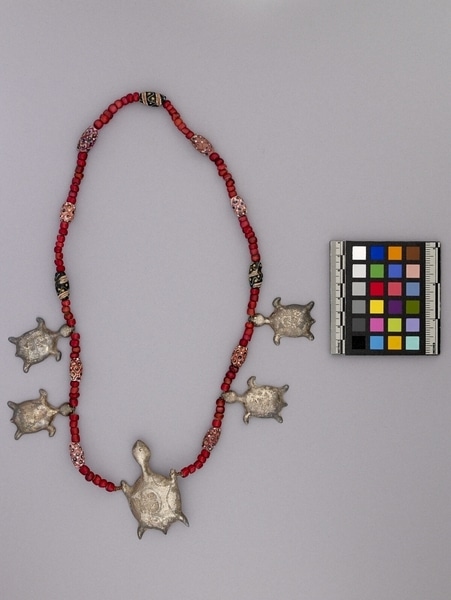Necklace Item Number: 1590/284 from the MOA: University of British Columbia

Description
Necklace of 101 glass beads and 5 hollow turtles strung on wire. There are 90 small red cylindrical beads and 11 barrel-shaped fancy “eye” and “stripe” beads. The small beads are separated at intervals by the barrel-shaped beads, 9 of which are predominantly pink and 2 predominantly black. The turtles all have zigzag engraving on backs and are spaced at intervals through lower half of necklace. The large turtle has engraved circles for eyes and two holes pierced in nose. The small turtles have embossed eyes and are strung through the nose. Large turtle is strung through pierced holes in front feet. All turtles have maker’s marks on back.
History Of Use
Silver ornaments represent an important part of early exchange between Europeans, including fur traders, and First Nations peoples, especially in eastern and central Canada and the U.S.A. Initially, the main source of silver was British, French and Spanish coins. Most ornaments were produced by silversmiths of European origin in North America and Europe, and were actively traded only from 1760 to 1821. By the mid-18th century silver objects were produced in New England, Quebec and Montreal. Silver was used by First Nations peoples as a sign of rank. Silver ornaments in these styles continue to be produced by native silversmiths in central Canada and the U.S.A.
Animal imagery is a significant part of Woodland First Nations tradition, but no documented instance has been found of the use of animal effigies in trade. The place of effigies in Woodlands culture is not known. The Iroquois legend of the turtle explains that the earth was formed from a lump of mud on the turtle’s back.. See Frederickson, page 59.
Specific Techniques
Repousse is a type of ornamentation formed in relief in metal by hammering up from the reverse or inner side.
Cultural Context
trade; personal decoration; status
Item History
- Made in Canada ? or USA ? between 1760 and 1821
- Owned by Kathleen E. Reif before September 9, 1993
- Received from Kathleen E. Reif (Donor) on September 9, 1993
What
Who
- Culture
- Eastern Woodlands
- Previous Owner
- Kathleen E. Reif
- Received from
- Kathleen E. Reif (Donor)
Where
- Holding Institution
- MOA: University of British Columbia
- Made in
- Canada ? or USA ?
When
- Creation Date
- between 1760 and 1821
- Ownership Date
- before September 9, 1993
- Acquisition Date
- on September 9, 1993
Other
- Item Classes
- metalwork
- Condition
- good
- Current Location
- Case 45
- Accession Number
- 1590/0284